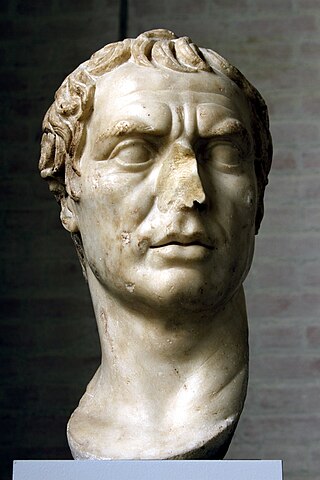Related Research Articles

The Roman triumph was a civil ceremony and religious rite of ancient Rome, held to publicly celebrate and sanctify the success of a military commander who had led Roman forces to victory in the service of the state or, in some historical traditions, one who had successfully completed a foreign war.

The Capitolium or Capitoline Hill, between the Forum and the Campus Martius, is one of the Seven Hills of Rome.

Vicus Tuscus was an ancient street in the city of Rome, running southwest out of the Roman Forum between the Basilica Julia and the Temple of Castor and Pollux towards the Forum Boarium and Circus Maximus via the west side of the Palatine Hill and Velabrum.
The Capitoline Triad was a group of three deities who were worshipped in ancient Roman religion in an elaborate temple on Rome's Capitoline Hill. It comprised Jupiter, Juno and Minerva. The triad held a central place in the public religion of Rome.

The Temple of Jupiter Optimus Maximus, also known as the Temple of Jupiter Capitolinus, was the most important temple in Ancient Rome, located on the Capitoline Hill. It was surrounded by the Area Capitolina, a precinct where numerous shrines, altars, statues and victory trophies were displayed.

The Forum of Augustus is one of the Imperial fora of Rome, Italy, built by Augustus. It includes the Temple of Mars Ultor. The incomplete forum and its temple were inaugurated in 2 BC, 40 years after they were first vowed.

Publius Cornelius Scipio Nasica Corculum was a politician of the Roman Republic. Born into the illustrious family of the Cornelii Scipiones, he was one of the most important Roman statesmen of the second century BC, being consul two times in 162 and 155 BC, censor in 159 BC, pontifex maximus in 150 BC, and finally princeps senatus in 147 BC.

The main road to the Roman Capitol, the Clivus Capitolinus starts at the head of the Roman Forum beside the Arch of Tiberius as a continuation of the Via Sacra; proceeding around the Temple of Saturn and turning to the south in front of the Portico Dii Consentes, it then climbs up the slope of the Capitoline Hill to the Temple of Jupiter Optimus Maximus at its summit. This was traditionally the last and culminating portion of all Roman triumphs.
Aemilia Tertia, properly Aemilia, was the wife of Scipio Africanus.
Lucius Cornelius Scipio was a statesman of the Roman Republic. He was the second son of Scipio Africanus, but despite this illustrious background, his career was cut short by his demotion from the senate by the censors in 174 BC.

The Tomb of the Scipios, also called the hypogaeum Scipionum, was the common tomb of the patrician Scipio family during the Roman Republic for interments between the early 3rd century BC and the early 1st century AD. Then it was abandoned and within a few hundred years its location was lost.

Publius Cornelius Scipio Africanus was a Roman general and statesman, most notable as one of the main architects of Rome's victory against Carthage in the Second Punic War. Often regarded as one of the greatest military commanders and strategists of all time, his greatest military achievement was the defeat of Hannibal at the Battle of Zama in 202 BC. This victory in Africa earned him the honorific epithet Africanus, literally meaning 'the African', but meant to be understood as a conqueror of Africa.
The lautumiae were tufa quarries that became a topographical marker in ancient Rome. They were located on the northeast slope of the Capitoline Hill, forming one side of the Graecostasis, where foreign embassies gathered prior to appearing before the Roman Senate.

The Temple of Jupiter Tonans was a small temple in Rome, dedicated by Augustus Caesar in 22 BCE to Jupiter, the chief god of ancient Rome. It was probably situated at the entrance to the Area Capitolina, the sanctuary of Jupiter on the Capitoline Hill, near the much older and larger Temple of Jupiter Optimus Maximus. The temple was considered among Augustus's most impressive archaeological projects, and played an important role in the Secular Games, a religious and artistic festival that he revived in 17 BCE. It was also noted by Roman authors for the artworks, particularly statues, displayed in and around it.

The Temple of Jupiter Feretrius was, according to legend, the first temple ever built in Rome. Its site is uncertain but is thought to have been on the Capitoline Hill.

Publius Cornelius Scipio was a priest of the Roman Republic, who belonged to the prominent family of the Cornelii Scipiones. He was the grandson of Scipio Africanus and son of P. Cornelius Scipio. He is only known from an inscription found in the Tomb of the Scipios, which tells that he was flamen Dialis, the prestigious priest of Jupiter.
The Temple of Mars in Clivo was a temple on the western side of the Via Appia in Rome, between the first and second milestones, built in the early 4th century BCE, and dedicated to Mars. It was the oldest standing temple dedicated to Mars within the city.

The Regio VIII Forum Romanum Magnum is the eighth regio of imperial Rome, under Augustus's administrative reform. Regio VIII took its name from the Roman Forum, the political centre of Ancient Rome.
The Arch of Fabius was an ancient Roman arch located at the eastern end of the Roman Forum.